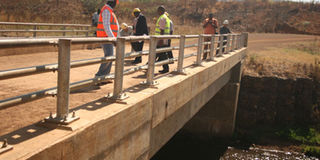Lamwo starts barley, wheat growing

Ministry of Works officials inspect the Aringa bridge in Lamwo District last week before it was handed over to government. PHOTO BY STEPHEN OTAGE
LAMWO.
Authorities in Lamwo have said the district will start trials of commercial wheat and barley growing this season following the completion of the Agoro Irrigation Scheme.
The scheme was repaired with funding from the African Development Bank to the tune of Shs27 billion.
While commissioning the Aringa Bridge last week, Mr Matthew Ochen Akiya, the district chairperson, said Lamwo had been cut off from most parts of Uganda because of lack of direct access there, yet it is endowed with some of the little known but important tourist attractions, fertile soils and very good weather to support wheat and barley production.
No access
“We had been cut off from accessing the most fertile part of the district; the Ministry of Agriculture has confirmed to us that we can grow barley and wheat. We also have a tourist site where King George II of England stayed as he sought asylum to surrender during World War II; we want to build a big hotel there,” he said.
He added that so far the district has managed to register 650 farmers who own plots at Lotuturu Prisons Farm which has over 1,600 acres of land to support commercial agriculture as opposed to the traditional low yielding crops such as maize, millet, sorghum, simsim and beans, which are no longer reliable.
“We already have the Agoro-irrigation scheme. Our coffee has been proved to do very well and fire has failed to destroy it in the last many years and the fruit has proved to be best in the country,” he said.
Aringa Bridge is among the six bridges that Multiplex, a local construction company, has built in Acholi Sub-region to open up access to the region to support internal trade and commerce within the region.
The bridge project was financed by the Japanese government at the cost of $4m (about Shs10 billion).
According to Mr Ochen Akiya, the bridge opens up Lamwo District which was the entry and exit point during the Kony war to the rest of the world.




